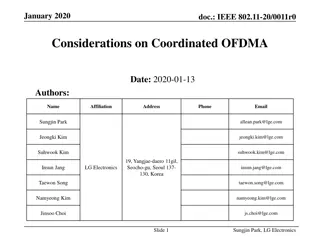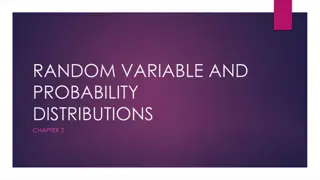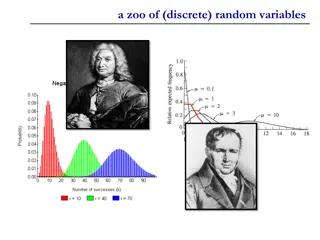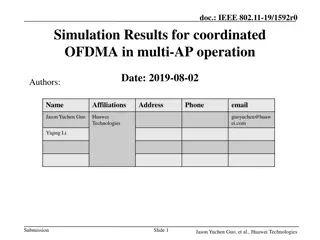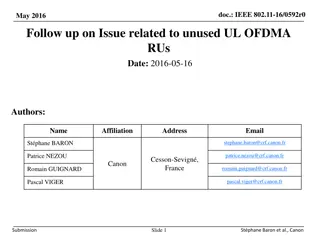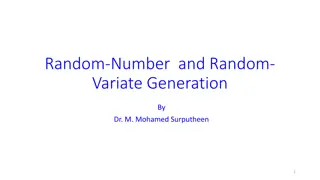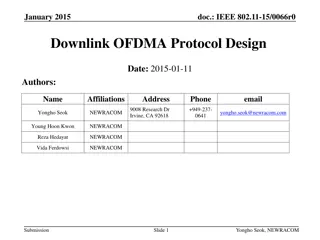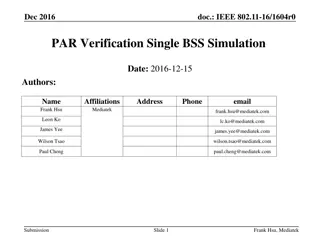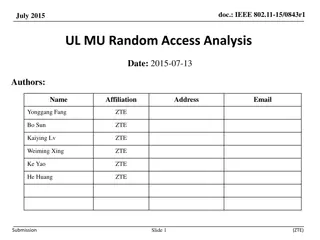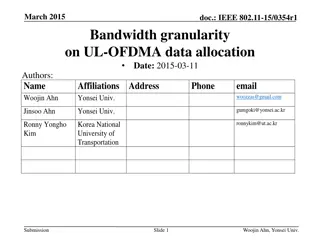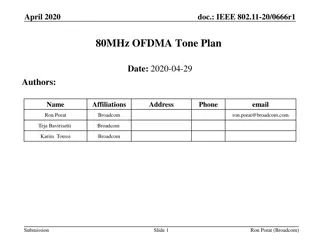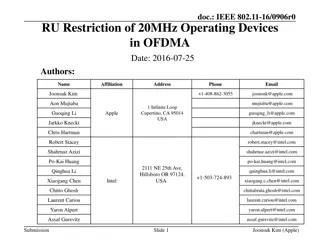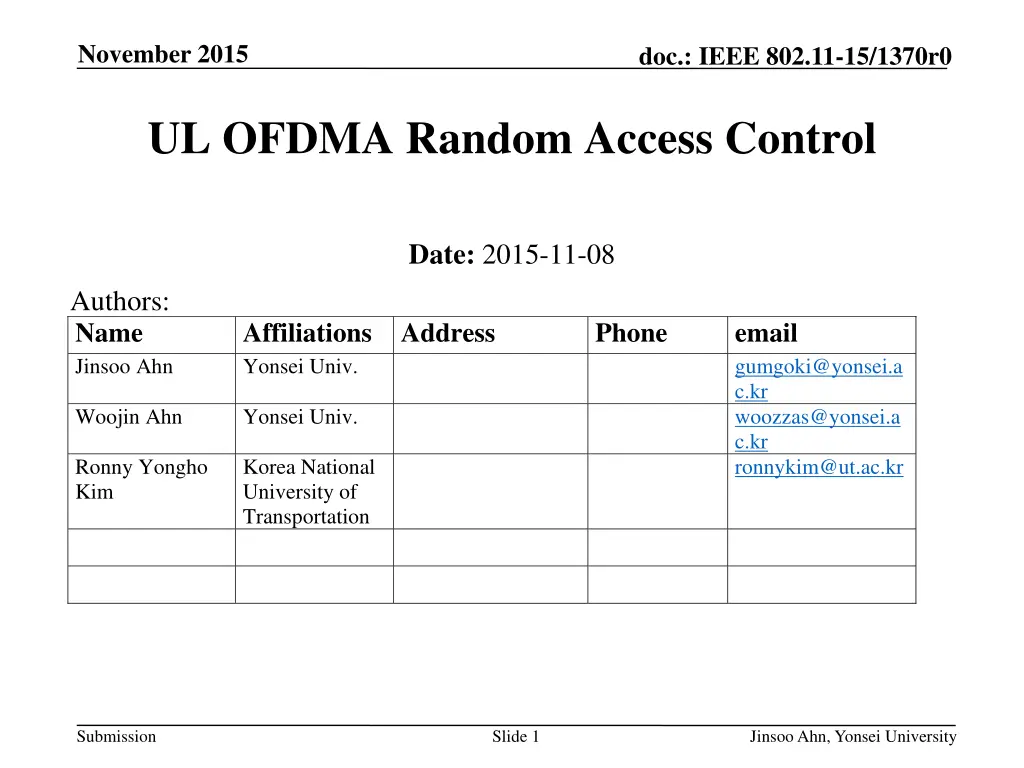
OFDMA Random Access Control in IEEE 802.11-15/1370r0
Explore the efficient OFDMA random access control mechanisms discussed in the document IEEE 802.11-15/1370r0. Topics include OBO efficiency, contention control, CWO optimization, and transmission probability for UL random access. Understand how elements like CWO and PTx impact contention levels and access delays in OFDMA systems.
Download Presentation

Please find below an Image/Link to download the presentation.
The content on the website is provided AS IS for your information and personal use only. It may not be sold, licensed, or shared on other websites without obtaining consent from the author. If you encounter any issues during the download, it is possible that the publisher has removed the file from their server.
You are allowed to download the files provided on this website for personal or commercial use, subject to the condition that they are used lawfully. All files are the property of their respective owners.
The content on the website is provided AS IS for your information and personal use only. It may not be sold, licensed, or shared on other websites without obtaining consent from the author.
E N D
Presentation Transcript
November 2015 doc.: IEEE 802.11-15/1370r0 UL OFDMA Random Access Control Date: 2015-11-08 Authors: Name Jinsoo Ahn Affiliations Address Yonsei Univ. Phone email gumgoki@yonsei.a c.kr woozzas@yonsei.a c.kr ronnykim@ut.ac.kr Woojin Ahn Yonsei Univ. Ronny Yongho Kim Korea National University of Transportation Submission Slide 1 JinsooAhn, Yonsei University
November 2015 doc.: IEEE 802.11-15/1370r0 Introduction TG approved OBO mechanisms and an OBO element in Trigger Frame during the last meeting[1] An HE AP is allowed to broadcast a TBD parameter in the trigger frame to the STAs so that STAs can initiate the random access process after the trigger frames OBO mechanism was considered under the identical priority case [2] 802.11e EDCA needs to be discussed in OBO situation Submission Slide 2 JinsooAhn, Yonsei University
November 2015 doc.: IEEE 802.11-15/1370r0 Contention Control OBO efficiency depends on traffic load OFDMA random access control needs to be considered in TF-R Variable CWO or Variable Transmission probability could be a possible solution [3] SFD states only one TBD parameter is included in trigger frame for contention control [1] [3] has shown PTxand CWO could be a one of the example of a TBD parameter in trigger frame AP broadcasts the randomization parameter(s) to the STAs, which can be Contention window size CWO Transmission probability PTX Etc. Submission Slide 3 JinsooAhn, Yonsei University
November 2015 doc.: IEEE 802.11-15/1370r0 OFDMA Contention Window (CWO) CWO is a window size of OBO Large CWO may cause long UL random access delay but small CWO could cause severe collision which causes much longer delay CWO value needs to be optimized depending on contention (congestion) level [2] already showed how different CWO min values control various contention levels Submission Slide 4 JinsooAhn, Yonsei University
November 2015 doc.: IEEE 802.11-15/1370r0 Transmission Probability (PTx) After OBO procedure, OFDMA p-persistence could be applied on UL OFDMA random access STAs If OFDMA p-persistence is adopted, OBO=0 STAs could transmit its data Frame with probability of PTx [3] has shown PTxand CWO could be a one of the example of a TBD parameter in trigger frame AP broadcasts the randomization parameter(s) to the STAs, which can be Contention window size Transmission probability Etc. PTxprovides immediate contention control for the TF-R TXOP Submission Slide 5 JinsooAhn, Yonsei University
November 2015 doc.: IEEE 802.11-15/1370r0 OBO parameter control CWOmin, CWOmax 6 RUs CWO BO CWO BO Controlling CWOmin value provides channel access delay control effect on data frame which is generated after trigger frame transmis sion p-persistent 6 RUs CWO BO p-percent access Controlling p-persistent value provides contention control effect on immediate TXOP Submission Slide 6 JinsooAhn, Yonsei University
November 2015 doc.: IEEE 802.11-15/1370r0 OBO Parameters for Access Categories 802.11e provides EDCA parameters for each Access Categories(ACs) Current OBO mechanism only considers the identical priority case When STAs with different ACs contend using OBO, OBO mechanism needs to provide parameters for ACs CWOmin, CWOmaxand TX Probability could be possible parameters for OFDMA EDCA CWO control and Tx probability control have their own pros. and cons. Submission Slide 7 JinsooAhn, Yonsei University
November 2015 doc.: IEEE 802.11-15/1370r0 OBO Parameters for Access Categories AC CWOmin TBD TBD TBD TBD TBD CWOmax TBD TBD TBD TBD TBD PTx(TBD) TBD TBD TBD TBD TBD Background (AC_BK) Best Effort (AC_BE) Video (AC_VI) Voice (AC_VO) Legacy DCF The table needs to be defined to support ACs on UL OFDMA Minimum size of RU, OFDMA TXOP, etc could be possible parameters for the Access Categories Submission Slide 8 JinsooAhn, Yonsei University
November 2015 doc.: IEEE 802.11-15/1370r0 OBO Parameters for Access Categories Current SFD does not allow broadcasting multiple parameters in the trigger frame If ACs are considered for OBO procedure, multiple OBO parameters need to be broadcast Indexing mechanism (e.g., contention index) can be used to efficiently indicate contention level Depending on the contention level, different CWO or PTXvalues can be applied Submission Slide 9 JinsooAhn, Yonsei University
November 2015 doc.: IEEE 802.11-15/1370r0 Example of contention index AC Parameter CWO PTx CWO PTx CWO PTx CWO PTx index = 1 4 <1 4 <1 2 <1 1 <1 index= 2 8 <1 8 <1 4 <1 2 <1 index= 3 16 <1 16 <1 8 <1 4 <1 BK BE VI VO *For each contention index, PTx(VO) PTx(VI) PTx(BE) PTx(BK) *Exact CWO values and PTxvalues are FFS Submission Slide 10 JinsooAhn, Yonsei University
November 2015 doc.: IEEE 802.11-15/1370r0 Contention index Contention index could be interpreted as a intensity of contention AP is assumed to have a capability to measure the intensity of contention roughly If AP recognizes contention level of UL random access is high, it advertise high contention index value to BSS via trigger frame Utilizing contention index could solve the problems of different parameters among different ACs Advertising single contention value cannot assure 802.11e priority on UL OFDMA Submission Slide 11 JinsooAhn, Yonsei University
November 2015 doc.: IEEE 802.11-15/1370r0 Conclusion Access Categories need to be considered in the OBO mechanism Parameters for OBO ACs CWOmin, CWOmax, PTx Trigger frame could advertise the index of contention level instead of specific contention parameter Advertising specific contention parameters (CWO or PTx) is not feasible for multiple ACs Submission Slide 12 JinsooAhn, Yonsei University
November 2015 doc.: IEEE 802.11-15/1370r0 StrawPoll 1 Do you agree to add to the TG Specification Frame work document? 4.5. A STA transmitting data using UL OFDMA random access shall follow OBO QoS parameters (TBD) for its access category. Y N A Submission Slide 13 JinsooAhn, Yonsei University
November 2015 doc.: IEEE 802.11-15/1370r0 StrawPoll 2 Do you agree to add to the TG Specification Frame work document? 4.5. The spec shall define a contention index field in the random access trigger frame to indicate contention level. Depending on the contention index value, TBD parameters (e.g., CWOmin, PTx, etc) are used for random access procedure. Y N A Submission Slide 14 JinsooAhn, Yonsei University
November 2015 doc.: IEEE 802.11-15/1370r0 References [1] 15/0132r9 Spec Framework [2] 15/1105r0 UL OFDMA-based Random Access Procedure [3] 15/1137r1 Triggered OFDMA Random Access Observations Submission Slide 15 JinsooAhn, Yonsei University


